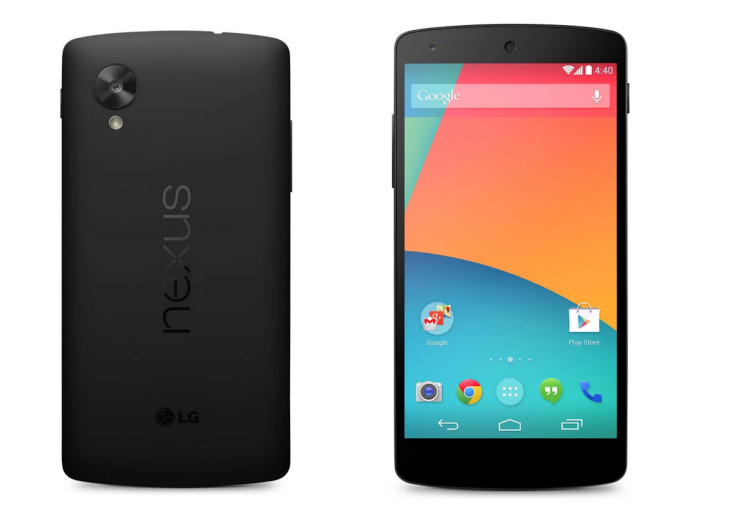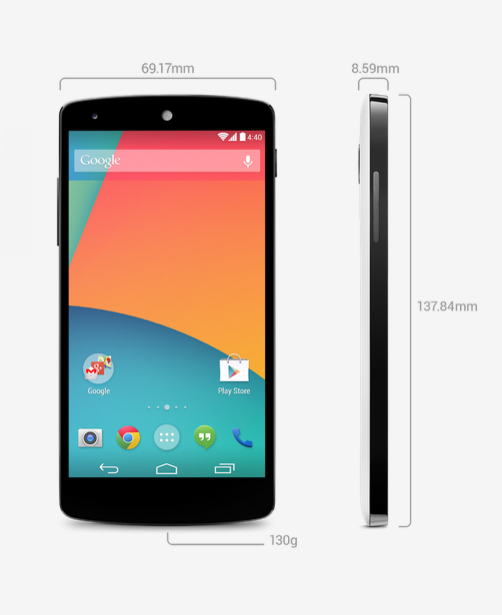Google Nexus 5 Review: In-Depth Hands-On With Android 4.4 KitKat On The LG Flagship

Google (NASDAQ:GOOG) released the Nexus 5 in Oct., partnering again with LG for an Android flagship, following the relative success and subsequent supply issues surrounding the Nexus 4. It costs $349 for a model with 16GB of storage ($399 for 32GB) compared to nearly twice as much for comparable devices from Motorola and Apple (NASDAQ:AAPL).
After using it almost exclusively since early Nov., I can say that I am not as disappointed as I was after spending a couple of days with the phone. The Nexus 5 is a great value, but fails to offer the groundbreaking, off-contract experience found with the Nexus 4. It does offer a beautiful screen and clean Android 4.4 KitKat experience, and for now I will be sticking with it over other Android heavy-hitters like the Moto X.
Nexus 5 Review: Its LG Predecessor, The Nexus 4
I used not one, but two Nexus 4 models. When I cracked the first one’s screen, I had tested a lot of smartphones (Android and otherwise) but still decided to buy another Nexus 4. That was because the Nexus 4 was a great smartphone not only because of its price — it was a great handset all around.
When it was first unveiled, the Nexus 4 was one of a few smartphones to contain a quad-core processor. Two GB of RAM was a major upgrade to the 512kb I was running with on the Samsung Galaxy S 4G, and the prospect with multitasking on Jelly Bean (Android 4.3) almost as well if not better than I could on a desktop was not just intriguing — it was a must own.
Wireless charging had not been adopted by flagship smartphones at their release, yet the Nexus 4 included it. Google also offered — at a premium price — a wireless charger made just for the Nexus 4. It looks a bit like the Death Star, or perhaps the Nexus Q, and it angles the Nexus 5 so that it is easy to use while the phone is charging.
It was a gorgeously designed charger that held the Nexus 4 in place using magnets. The only downside was that a few drops of the Nexus 4 would weaken the magnetic force, making it accidentally come off the charger much easier.
The Nexus 4 was fast on T-Mobile’s HSPA+ network. A tower nearby my home in Long Beach, NY allowed me 3G+ speeds, even on the beach, while my wife’s Verizon Wireless handsets dropped calls like hot potatoes. I started paying less by switching to T-Mobile’s unlimited “uncarrier” plans, was unrestricted by a draconian two-year contract, and was happy.
I liked the way the Nexus 4 felt in my hand. The rubberized side-grip that surrounded the Nexus 4 made it feel great without a case (much to my later chagrin). Coupled with a glass back, the Nexus 4 was easily handled and perfectly balanced. It was not as clumsy or lacking in app support as a Windows Phone. An elegant smartphone, from a more civilized age.

Nexus 5 Review: Hardware
The Nexus 5 features Corning’s third iteration of Gorilla Glass, which makes it delightful to swipe a text or crush candy bits on. Corning claims Gorilla Glass 3 is 40 percent more scratch-resistant and three times more damage-resistant than the previous formula. I am glad to find that it is more shatter-resistant as welI, since I broke not one, but two separate Nexus 4 models. I do not have a screen cover on the Nexus 5, and have found it in the same pocket as my keys on more than one occasion. Unlike devices using Gorilla Glass 2, the Nexus 5 comes out unscathed.
LG has included a screen on the Nexus 5 that, much like on the company's G2, is absolutely gorgeous. I never expected to be so blown away with 1080p on a smartphone, but LG nails it with the Nexus 5. It looks great in broad daylight, and the combination of a higher resolution along with a 4.95-inch screen makes the Nexus 5 nearly the perfect size.
While it's slightly more difficult to reach all areas of the screen with one hand on the Nexus 5, I can now view complex spreadsheets in Google Drive without having to mess around too much with zoom. Even desktop versions of websites look great with Chrome on the Nexus 5, despite being jam-packed with photos and text.
The Nexus 5 in white offers a shiny, black plastic side. The black offers a more matte look, but is even more of a fingerprint magnet. The ceramic buttons on the Nexus 5 took some getting used to — they are thinner and offer slightly more resistance than other Android smartphones — but eventually I began to prefer them. Phone calls are generally loud and clear on the receiving end, but many of my contacts told me I sounded muffled or hard to understand, even when speaking clearly.
The camera sticks out from the back of the Nexus 5, as opposed to a flush mounting found on its predecessor. This strikes me as a strange design decision — why not make the whole thing smooth? I truly like the Nexus 5 camera. While its no match for the Nokia Lumia 1520, the Nexus 5’s camera takes clear shots, and is not terrible in low light, especially with the fixes that came with 4.4.2.
Wireless charging is available with the Nexus 5, but the charger is expensive and not as impressive as the one that Google offered with the Nexus 4. Buyers would be better off getting a Lumia charger when one is on sale from AT&T (for $12-$15) than paying $50 for the Nexus Wireless Charger.
The most serious issue with the Nexus 5 are the phone's GPS issues. Several users are complaining about various issues about the phone being able to pick up satellite signals for navigation, and the 16GB White Nexus 5 I used for review takes several minutes to hours to lock on. I recently travelled from New York City to Upstate New York, and the GPS did not lock on until I was nearly halfway there. My wife's iPhone 5S had no issues, luckily. Google has not responded to a request for comment on whether this is an isolated hardware incident or a widespread issue.
The bottom line is that LG did not innovate with the Nexus 5 like it did with the 4. This could be their fault, or it could be Google’s, since the folks in Mountain View may have been saving all the neat tricks for Motorola and the Moto X and Droid lines. Much like when it was impossible to order a Nexus 4 due to supply issues, the fact of the matter is it does not matter whose fault the shortcomings of the Nexus 5 is. I am just disappointed. I really do enjoy using the Nexus 5, but it is a much less exciting option than its predecessor.
Google would do well to find a new hardware partner for its Nexus line next time around.

Nexus 5 Review: Android 4.4.2 KitKat Is Two Steps Forward, One Step Back
When I first got the Nexus 5, the most striking thing was how much more complicated it was to call back a recently missed contact or send a text message. Android 4.4 KitKat included Hangouts in lieu of a standard SMS messaging app, forcing SMS support into the Google ecosystem. It was a bad fit.
Often, I would send a message through Hangouts by accident instead of as a text. iPhone users would never see my message, unless they were signed in to Gmail accounts on a desktop. The way that Hangouts melded SMS messaging with a data-based messaging app (like BBM, Viber or WhatsApp) made it feel like Mountain View was cramming Google+ down my throat.
Backspacing an entire text was entirely too easy, with no ‘undo’ button available. This was fixed in a later update. However, changes made to the Google keyboard’s punctuation made it easier to use. Unfortunately, there is still no “.com” button for email addresses, and no designated number tray at the top of Android 4.4.2’s keyboard, which means you have to long press for numbers. This wastes time. On a 4.95-inch screen like the one found on the Nexus 5, there is plenty of room to include a dedicated number row.
When Android “Jelly Bean” updated to Android 4.3 from 4.2, the Google Keyboard began to include a Swype-like text input, known as gesture-based typing. This was a huge update — no longer did I need to use a third-party app like Swype. Google stole the idea, and implemented it better.
The lock screen began to include widgets on Android 4.3, as well as the ability to swipe directly to the camera. The camera was completely redesigned, and included the new “Photo Sphere” feature.
That was a big update. Android 4.4 only offers two things that made the operating system more intuitive and fun to use — on the Nexus 5, swiping to the left offered a quicker way to glance at Google Now, and included in Developer’s Options was the ability to run in the Android Runtime.
The Android Runtime (ART) is the crucial to the OS, it implements its behavior and has a huge impact on all aspects of Android. Luckily, ART is more efficient than its predecessor, the Dalvik Runtime (DRT), and offers quicker speeds and better battery life. Now we’re talking, Google.
Nexus 5 Review: The Bottom Line
LG has crafted a neat smartphone with the Nexus 5, and it is remarkably better than the company’s own G2. Unfortunately, the Nexus 5 is not nearly as innovative as its predecessor, and while its larger, higher-resolution screen is beautiful, it fails to clearly trump competing Android devices like the Moto X, let alone offerings from Apple and Nokia.
It might be a sign of the times, as smartphones may have finally reached a peak hardware where a slew of complex apps can run at the same time, but the Nexus 5, while a capable device, is no great leap forward.
Follow Thomas Halleck on Twitter and let him know how wrong (or right) he is about LG and Google’s
Nexus 5.
© Copyright IBTimes 2024. All rights reserved.





















